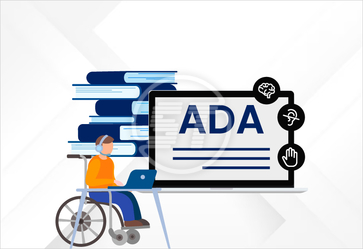Maximum accessibility is expected in the digital world due to increasing dependency on digital products. A profound number of disabled individuals are facing discrimination at some point while trying to access digital environments. However, the situation is improving with time and organizations are trying to include accessibility in their digital products.
Along with distinct accessibility standards implementation, one of the ways to comply with Section 508, WCAG and other international standards is by filling out a Voluntary Product Accessibility Template (VPAT). It is a proof of organization’s commitment to digital inclusivity. VPAT contains information about the website’s level of conformance, and it is generally filled out by web accessibility experts.
YOU MIGHT ALSO LIKE: The difference between ADA and Section 508.
VPAT for Section 508 & WCAG – A mandate by law!
Each government agency, federally funded organizations, and other private companies are required to comply with Section 508 in the US. Organizations that are obligated to comply with Section 508, endeavour to modify their websites/applications under different versions of (2.0, 2.1, and 2.2) WCAG; however, WCAG 2.0 level AA is essential and should be documented in the VPAT of the website.
The Information Technology Industry Council (ITI) and the US government’s General Services Administration (GSA) collaborated in 2001 to create the VPAT service. Its first revision happened in 2017 when ITI released VPAT 2, which was made for the revised requirements of Section 508. The latest version is VPAT 2.4, and it was released in February 2020.
The VPAT is tailored to address specific requirements of distinct standards.
WCAG Edition –
It is suitable for organizations and vendors that want to display their efforts of adherence to WCAG standards. This edition of VPAT is available in all four editions of VPAT. Organizations that face lawsuits issues for not complying with the ADA, can fill out this VPAT edition as one of their endeavours to remediate their websites.
Section 508 Edition –
It is designed to report revised Section 508 requirements and WCAG compliance.
EU Edition –
It caters to all organizations and vendors who ought to report compliance with European Standards EN 301549 along with WCAG.
INT Edition –
The international edition consists of all three requirements of WCAG, Section 508, and European Standards EN 301549. It caters to an international audience and enables organizations to reach out to the global market.
Which organizations ought to fill out VPAT?
Is your organization in one of the below-mentioned categories? If yes, then you are required to complete VPAT requisites to comply with Section 508.
U.S. Federal Agencies
Government entities including all Departments of State, Environmental Protection Agency, Department of Defence, and all other agencies.
Federally funded organizations and all service providers
Companies that offer digital products and services such as software development companies and every organization that receives federal financial assistance are expected to complete VPAT requirements.
State, County, and Municipal Jurisdiction
Entities that are open to the public at the state, county, and municipal levels and receive federal financial help are obligated to fill out VPAT. For example, state transportation departments, public schools, universities, local police departments, etc.
All the entities written here must have accessible ICT with complete VPAT. Their websites, podcasts, any form of digital content, emails, e-learning, remote access tools, etc. must fill out a VPAT with the details that have been taken to make them accessible.
What details one can find in a VPAT?
There is a readymade format for the VPAT document available as a Microsoft Word file that can be used the way it is or changed in any other required format such as PDF. The VPAT has two sections; the first one consists of all instructions to complete the VPAT and the second section is the VPAT template itself, wherein all accessibility details are to be filled. The second section is also known as the Accessibility Conformance Report (ACR).
The details that you will find in the second section of VPAT include criteria for various platforms.
- Accessibility criteria.
- Conformance level.
- Additional remarks about testing methodology and/or any other conformance details.
Conformance levels can be described as,
- Supports – It means the digital product functionalities meet the conformance criterion without known defects.
- Partially Supports – Some of the functionalities do not meet the conformance criterion.
- Does not Support – Major functionalities of the digital product are non-compliant.
- Not Applicable – The conformance criterion cannot be applied to the product.
- Not Evaluated – The digital product has not been evaluated against the suggested criterion if it is about level AAA only.
All answers must be clearly written. Organizations can furnish supporting documents, authoring tools, and software to describe the methodology. Moreover, the VPAT document should be accessible. If you convert it to other formats such as PDF, ensure to check its accessibility.

What is the process to complete the VPAT?
The process begins with the Section 508 and WCAG audit by web accessibility experts who know accessibility guidelines and methodologies thoroughly. Though the audit can be done in-house as well, an expert can evaluate the digital product precisely according to the guidelines and complete the VPAT process accurately.
Thus, there should be a reliable expert on board that can complete the entire VPAT process for your digital product. The document produced by an expert VPAT service provider is more objective and helps to fulfil Section 508 and WCAG requirements.
How frequently a VPAT be updated?
Well, it solely depends on how frequently an organization updates its content. If some significant changes have been made in the web content or VPAT released any new features, then it is crucial to update the VPAT. Ideally, organizations should update their VPAT every 12 to 16 months so that it reflects the most recent compliance level of the digital properties.
You may also like: Website Accessibility Audit
Wrapping up
So, the idea behind VPAT development was to provide a standard format to display compliance reports and the accessibility level of digital products. Always remember that a complete VPAT (including ACR) is needed to save your websites/applications from the exclusion of any type of solicitations.
Complete VPAT always accords your products' additional advantages when it comes to accessibility checks and comparison with competitors’ products. Therefore, keep your VPAT updated to make sure it offers robust and comprehensive accessibility details.
Hire a seasoned VPAT service provider to get it done correctly!
Are your business website and other digital assets ADA compliant? Or are you looking for guidance on ADA web accessibility standards? All these that you are in search of are available here at Skynet Technologies. As a prominent ADA website accessibility service provider, Skynet Technologies will guide you and help you make your business website and your any other digital assets ADA compliant. Get in touch with us at [email protected] or submit the following request free quote form to know more.


